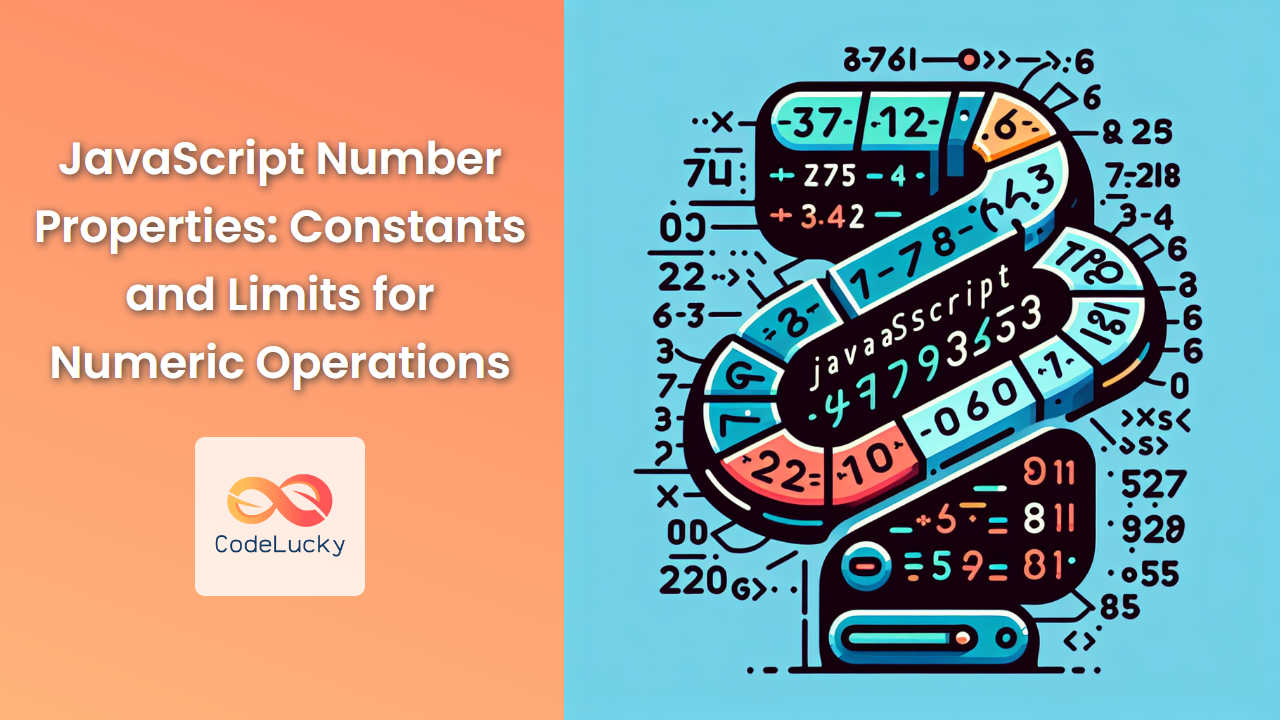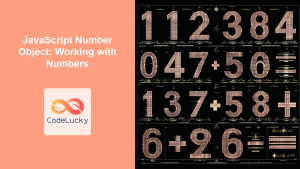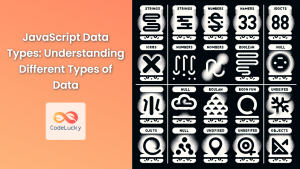JavaScript, as a versatile programming language, offers a rich set of built-in properties for working with numbers. These properties, often overlooked by beginners, play a crucial role in mathematical operations, error handling, and ensuring precision in numerical computations. In this comprehensive guide, we'll explore the various number properties in JavaScript, their significance, and how to leverage them effectively in your code.
Understanding JavaScript's Number Object
Before diving into the specific properties, it's essential to understand that in JavaScript, numbers are represented by the Number object. This object serves as a wrapper for numerical values and provides a set of useful properties and methods.
Let's start by examining these properties one by one:
1. Number.EPSILON
📊 Number.EPSILON represents the smallest interval between two representable numbers in JavaScript.
This property is particularly useful when dealing with floating-point arithmetic, where small rounding errors can occur due to the binary nature of computers.
console.log(Number.EPSILON); // Output: 2.220446049250313e-16
function areAlmostEqual(a, b) {
return Math.abs(a - b) < Number.EPSILON;
}
console.log(areAlmostEqual(0.1 + 0.2, 0.3)); // Output: true
console.log(0.1 + 0.2 === 0.3); // Output: false
In this example, we've created a function areAlmostEqual that uses Number.EPSILON to determine if two numbers are approximately equal. This is particularly useful because direct equality comparisons with floating-point numbers can be unreliable due to precision issues.
2. Number.MAX_VALUE
🔝 Number.MAX_VALUE represents the largest positive finite number that can be represented in JavaScript.
This property is crucial when you need to check if a number exceeds the maximum allowed value in JavaScript.
console.log(Number.MAX_VALUE); // Output: 1.7976931348623157e+308
function safeMultiply(a, b) {
let result = a * b;
if (result === Infinity || result === -Infinity) {
throw new Error("Result exceeds maximum representable number");
}
return result;
}
console.log(safeMultiply(1e200, 1e200)); // Throws: Error: Result exceeds maximum representable number
console.log(safeMultiply(1e100, 1e100)); // Output: 1e+200
In this example, we've created a safeMultiply function that checks if the result of multiplication exceeds Number.MAX_VALUE. This helps prevent silent overflow errors in calculations.
3. Number.MIN_VALUE
🔍 Number.MIN_VALUE represents the smallest positive number that can be represented in JavaScript.
This property is useful when dealing with very small numbers close to zero.
console.log(Number.MIN_VALUE); // Output: 5e-324
function isSignificant(num) {
return Math.abs(num) >= Number.MIN_VALUE;
}
console.log(isSignificant(1e-323)); // Output: true
console.log(isSignificant(1e-324)); // Output: false
console.log(isSignificant(0)); // Output: false
Here, we've created an isSignificant function that checks if a number is greater than or equal to Number.MIN_VALUE. This can be useful in scientific calculations or financial applications where very small numbers might need to be treated differently.
4. Number.MAX_SAFE_INTEGER
🔢 Number.MAX_SAFE_INTEGER represents the maximum safe integer in JavaScript (2^53 – 1).
This property is crucial when working with large integers, especially in scenarios involving IDs or timestamps.
console.log(Number.MAX_SAFE_INTEGER); // Output: 9007199254740991
function incrementSafely(num) {
if (num >= Number.MAX_SAFE_INTEGER) {
throw new Error("Cannot safely increment: Maximum safe integer reached");
}
return num + 1;
}
console.log(incrementSafely(9007199254740990)); // Output: 9007199254740991
console.log(incrementSafely(9007199254740991)); // Throws: Error: Cannot safely increment: Maximum safe integer reached
In this example, we've created an incrementSafely function that checks if incrementing a number would exceed Number.MAX_SAFE_INTEGER. This is particularly useful in scenarios where you're dealing with large numbers and want to ensure precision.
5. Number.MIN_SAFE_INTEGER
⬇️ Number.MIN_SAFE_INTEGER represents the minimum safe integer in JavaScript (-(2^53 – 1)).
This property is the negative counterpart of MAX_SAFE_INTEGER and is useful when working with large negative integers.
console.log(Number.MIN_SAFE_INTEGER); // Output: -9007199254740991
function decrementSafely(num) {
if (num <= Number.MIN_SAFE_INTEGER) {
throw new Error("Cannot safely decrement: Minimum safe integer reached");
}
return num - 1;
}
console.log(decrementSafely(-9007199254740990)); // Output: -9007199254740991
console.log(decrementSafely(-9007199254740991)); // Throws: Error: Cannot safely decrement: Minimum safe integer reached
Similar to the previous example, decrementSafely ensures that we don't go below the minimum safe integer, which is crucial for maintaining numerical precision.
6. Number.POSITIVE_INFINITY
➕∞ Number.POSITIVE_INFINITY represents infinity in JavaScript.
This property is useful when dealing with mathematical operations that result in infinity or when you need to represent an unbounded upper limit.
console.log(Number.POSITIVE_INFINITY); // Output: Infinity
function divideWithInfinityCheck(a, b) {
let result = a / b;
if (result === Number.POSITIVE_INFINITY) {
return "Result is infinitely large";
}
return result;
}
console.log(divideWithInfinityCheck(1, 0)); // Output: "Result is infinitely large"
console.log(divideWithInfinityCheck(10, 2)); // Output: 5
In this example, divideWithInfinityCheck uses Number.POSITIVE_INFINITY to check if a division operation results in infinity, allowing for more informative error handling.
7. Number.NEGATIVE_INFINITY
➖∞ Number.NEGATIVE_INFINITY represents negative infinity in JavaScript.
This property is the negative counterpart of POSITIVE_INFINITY and is useful in similar scenarios involving very large negative numbers or unbounded lower limits.
console.log(Number.NEGATIVE_INFINITY); // Output: -Infinity
function exponentiateWithInfinityCheck(base, exponent) {
let result = Math.pow(base, exponent);
if (result === Number.NEGATIVE_INFINITY) {
return "Result is negative infinity";
} else if (result === Number.POSITIVE_INFINITY) {
return "Result is positive infinity";
}
return result;
}
console.log(exponentiateWithInfinityCheck(-2, 1000)); // Output: "Result is negative infinity"
console.log(exponentiateWithInfinityCheck(2, 1000)); // Output: "Result is positive infinity"
console.log(exponentiateWithInfinityCheck(2, 3)); // Output: 8
Here, exponentiateWithInfinityCheck uses both NEGATIVE_INFINITY and POSITIVE_INFINITY to provide meaningful feedback when exponentiation results in extremely large positive or negative numbers.
8. Number.NaN
❓ Number.NaN represents "Not-a-Number" in JavaScript.
This property is crucial for handling invalid mathematical operations or parsing failures.
console.log(Number.NaN); // Output: NaN
function safeSquareRoot(num) {
if (num < 0) {
return Number.NaN;
}
return Math.sqrt(num);
}
console.log(safeSquareRoot(16)); // Output: 4
console.log(safeSquareRoot(-4)); // Output: NaN
function isValidResult(result) {
return !Number.isNaN(result);
}
console.log(isValidResult(safeSquareRoot(16))); // Output: true
console.log(isValidResult(safeSquareRoot(-4))); // Output: false
In this example, safeSquareRoot returns Number.NaN for invalid inputs (negative numbers). The isValidResult function then uses Number.isNaN() to check if a result is valid.
Practical Applications of Number Properties
Now that we've explored each property in detail, let's look at some practical applications where these properties can be particularly useful:
1. Financial Calculations
When dealing with currency and financial calculations, precision is crucial. Using Number.EPSILON can help manage floating-point arithmetic errors:
function addCurrency(amount1, amount2) {
const sum = amount1 + amount2;
return Number((sum).toFixed(2));
}
console.log(addCurrency(0.1, 0.2)); // Output: 0.3
console.log(0.1 + 0.2); // Output: 0.30000000000000004
2. Scientific Computations
In scientific applications, you might need to deal with very large or very small numbers. MAX_VALUE, MIN_VALUE, and the infinity properties can be helpful:
function normalizeScientificValue(value) {
if (Math.abs(value) < Number.MIN_VALUE) {
return 0; // Treat as zero if smaller than representable
} else if (value > Number.MAX_VALUE) {
return Number.POSITIVE_INFINITY;
} else if (value < -Number.MAX_VALUE) {
return Number.NEGATIVE_INFINITY;
}
return value;
}
console.log(normalizeScientificValue(1e-324)); // Output: 0
console.log(normalizeScientificValue(1e309)); // Output: Infinity
console.log(normalizeScientificValue(-1e309)); // Output: -Infinity
console.log(normalizeScientificValue(1000)); // Output: 1000
3. Input Validation
When accepting numerical input from users, it's important to validate that the numbers are within safe ranges:
function validateUserInput(input) {
const num = Number(input);
if (Number.isNaN(num)) {
return "Please enter a valid number";
} else if (num > Number.MAX_SAFE_INTEGER || num < Number.MIN_SAFE_INTEGER) {
return "Number is outside the safe integer range";
}
return "Input is valid: " + num;
}
console.log(validateUserInput("123")); // Output: "Input is valid: 123"
console.log(validateUserInput("1e20")); // Output: "Number is outside the safe integer range"
console.log(validateUserInput("abc")); // Output: "Please enter a valid number"
4. Performance Optimization
Understanding these number properties can also help in optimizing performance. For instance, when working with large datasets:
function optimizedSum(arr) {
let sum = 0;
for (let i = 0; i < arr.length; i++) {
if (sum > Number.MAX_SAFE_INTEGER - arr[i]) {
return Number.POSITIVE_INFINITY; // Avoid unnecessary calculations
}
sum += arr[i];
}
return sum;
}
const largeArray = Array(1000000).fill(1000);
console.log(optimizedSum(largeArray)); // Output: Infinity
In this example, we stop the summation early if we detect that the result will exceed MAX_SAFE_INTEGER, saving unnecessary computations.
Conclusion
JavaScript's number properties are powerful tools that every developer should be familiar with. They provide a way to handle edge cases in numerical operations, ensure precision in calculations, and create more robust and error-resistant code.
By leveraging these properties effectively, you can:
- Improve the accuracy of floating-point arithmetic
- Handle very large or very small numbers gracefully
- Validate numerical inputs more effectively
- Optimize performance in numerical computations
- Create more informative error messages for mathematical operations
Remember, while JavaScript provides these properties to help manage numerical operations, it's always important to consider the specific requirements of your application. In some cases, especially when dealing with very precise financial calculations or extremely large numbers, you might need to consider using specialized libraries or alternative data types.
As you continue to work with JavaScript, make it a habit to consider these number properties in your numerical operations. They can be the difference between code that works most of the time and code that works reliably all the time, even in edge cases.



















